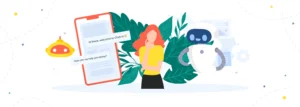AI Chatbots for Universities: Use Cases, Examples, and What to Consider
Your admissions team answers the same 200 questions every day. During enrollment periods, student support requests pile up. International students struggle to navigate complex processes across different time zones. Meanwhile, student engagement drops as help feels inaccessible when it’s needed most.
Universities engage with thousands of students daily, yet many institutions still rely on office hours and email chains to manage these interactions. You realize that this approach is, at best, inefficient, right?
As an administrator, you want to optimize interactions with both prospective and current students so you can focus your resources on what matters most: education itself. You’re looking for ways to do this, and AI-powered solutions are your answer.
Chatbot tools help solve real operational challenges. They improve the student experience, streamline enrollment, provide professors with analytics-driven insights, and help university staff automate administrative tasks. Chatbots in higher education are changing the way institutions operate.
At AnyforSoft, we’ve built chatbot platforms for educational institutions facing numerous challenges. Our many years of experience in education software development show us that the right AI implementation not only reduces workload but also changes student performance outcomes.
This article looks at real-world examples of universities using AI-powered chatbots, practical applications that deliver results, and what your institution should consider when creating chatbots for your specific needs.
You may also be interested in our previous article on chatbots vs conversational AI, where we discussed AI-powered chatbots and their numerous applications.
Why Universities Are Investing in AI Chatbot Technology
AI chatbots for universities use artificial intelligence, machine learning, and natural language processing to understand student queries and provide human-like responses. Unlike basic rule-based systems (i.e., software without artificial intelligence), these tools learn from student conversations and improve over time — chatbots can answer any question, regardless of how it is phrased.
The investment makes sense when you consider what these platforms offer:
Increased student engagement and 24/7 support
Chatbots are becoming indispensable for student support that doesn’t pause for weekends or holidays. International students especially benefit from round-the-clock assistance as they navigate new systems and time zones. Instead of waiting for business hours, they receive immediate help with class schedules, campus locations, and access to learning materials.
Streamlined enrollment processes
Large educational institutions process thousands of applications annually. Harvard University received over 56,000 applications for the 2024 academic year, accepting only 1,966 students.
A well-designed chatbot for universities can guide applicants through requirements, gather documents, and track application deadlines – reducing administrative burden and improving the applicant experience. Find out more in our article on machine learning in education.
Data-driven insights from student interactions
Every conversation generates valuable data about students that reveals pain points, common questions, and opportunities for improvement. Universities can identify where prospective students are struggling, what current students need most, and how to optimize their services accordingly.
Centralized access to information
Instead of forcing students to hunt through complex websites, chatbots in higher education deliver targeted information on demand. Students ask specific questions and get specific answers — no more scrolling through countless pages to find a simple answer.
Cost-effective scalability
While human interaction remains valuable for complex issues, chatbots efficiently handle routine student inquiries. This allows staff to focus on higher-level student support while ensuring immediate answers to basic questions.
Improved lead generation
Higher ed chatbot systems naturally capture contact information from prospective students during conversations, creating opportunities for universities to interact more effectively with potential applicants.
Reduced administrative errors
Chatbot platform responses draw from verified data sources, minimizing human errors that can occur during periods of high workload or staff turnover.
Common Uses of AI Chatbots for Universities
Educational institutions deploy AI chatbots across multiple touchpoints, each serving specific operational needs:
- Course scheduling and registration management
Student engagement increases when registration is seamless. Chatbots in higher education help students navigate course prerequisites, check seat availability, and resolve scheduling conflicts. The chatbot for universities can also send automated reminders about registration deadlines and course add/drop periods.
- Library services and resource navigation
Students access digital resources, reserve study spaces and get research assistance through live chat integration. The system guides users to specific databases, citation tools and research support based on their academic needs.
- Learning management system integration
Chatbot platform technology connects with existing LMS infrastructure to help students locate assignment submissions, check grades, and understand course requirements. This personalized support reduces confusion and improves academic performance.
- Event management and campus communications
Universities use chatbots to distribute event notifications, manage RSVPs and provide real-time updates during campus emergencies. International students especially benefit from automated translations and culturally relevant event recommendations.
- Feedback collection and institutional research
Student data collection becomes more efficient when chatbots conduct surveys, gather program feedback, and track student satisfaction metrics. This creates actionable insights for continuous improvement.
- Career services and job placement support
Support students in their professional development through resume feedback, interview preparation and job search assistance. The system can match students with relevant internship opportunities and career resources.
- Maintenance and facilities management
Students report campus issues, request room reservations and get updates on facility availability through chatbot interfaces. This streamlines campus operations while providing students with immediate status updates.
- Alumni engagement
Universities use chatbots to maintain connections with graduates, sharing updates about programs, events, and opportunities for ongoing engagement.
Real Examples: How Universities Use AI Chatbots
Georgia State University
Georgia State University is a perfect example of how a chatbot in higher education can greatly improve many processes within an organization. The university developed Pounce, a comprehensive chatbot platform that handles admissions questions, schedules campus tours, and connects students with counselors. The system is available on their website and through text messaging, so students can get help through their preferred communication method.
University of Wisconsin-Madison
The University of Wisconsin-Madison created Ask Bucky to guide prospective students through the admissions process. The chatbot answers questions about application deadlines, financial aid, and campus life on their website and Facebook Messenger. It is another great example of the smart implementation of a chatbot for higher education.
California State University
California State University, Northridge uses CSUNny to support admitted students during enrollment. The system sends deadline reminders and provides information about academic advising, housing, and financial aid through multiple channels.
Leeds Beckett University
Leeds Beckett University uses Becky to handle course queries, entry requirements, and accommodation questions on Facebook Messenger. The university chatbot operates during office hours and has seen a significant increase in inquiries from prospective students.
These examples show how chatbot platform technology can be tailored to different institutions’ needs while maintaining consistent student support quality.
Custom Chatbots for Educational Institutions vs. GPT Subscription: What Makes the Difference?
A university chatbot needs to answer questions about your programs, your deadlines, your policies. Generic AI tools weren’t built for this.
Why Custom Chatbots Outperform Standard GPT Subscriptions
ChatGPT draws answers from the open internet. It approximates based on patterns from millions of websites. When it guesses wrong about your application deadlines or financial aid requirements, students receive inaccurate information and your staff fixes the errors.
Custom chatbots train exclusively on your institutional content — course catalogs, admissions policies, academic calendars, verified documentation. The system won’t guess. If it lacks information, it escalates to staff. Every answer comes from sources you control.
ChatGPT operates as a standalone tool. A custom solution integrates with your LMS, student information system, CRM, and portal. It pulls real-time enrollment data, updates records, completes tasks within your workflows. Students receive answers based on their specific circumstances, not general advice.
Custom Chatbot vs. GPT Subscription: Key Differences
| Factor | Paid GPT Subscription | Custom AI Chatbot |
| Training Data Source | Open internet; broad, general knowledge base | Your institutional content only — programs, policies, verified documents |
| Integration Capabilities | Standalone tool; no direct system connections | Connects with LMS, SIS, CRM, student portals for real-time, context-aware responses |
| Accuracy & Reliability | Approximates answers; prone to hallucinations when guessing institutional details | Grounded in verified data; won’t guess — escalates unclear queries to staff |
| Branding & Voice | Generic AI tone; unpredictable style | Matches your communication standards; feels like an official campus resource |
| Compliance & Security | Limited control over data handling; not designed for FERPA/GDPR environments | Built with role-based access, audit logs, consent flows; compliance at the core |
| Cost Structure | Subscription per user; scales with team size | Custom build investment; scalable without per-user fees |
California Lutheran University: Ask Gumby Transforms Student Support
California Lutheran University deployed Ask Gumby across their student portal and mobile app. The assistant answers academic and administrative questions using institutional data.
The implementation delivered measurable results across student support operations:
- Financial aid follow-up questions decreased 70%. Students accessed deadline explanations, documentation requirements, and aid process details instantly. The financial aid team shifted focus to complex cases requiring human expertise.
- Unpaid graduation fees dropped 75%. Students received timely guidance on requirements and forms when they needed it. Round-the-clock availability removed friction points that previously delayed completion.
- Overall satisfaction with the university’s digital portal reached 96%. The assistant handles routine inquiries while staff concentrate on issues requiring their judgment.
The assistant reduced administrative workload while maintaining human support for complex student needs.
Wittenborg University: Fast, Budget-Friendly Custom AI Implementation
AnyforSoft developed an AI assistant for Wittenborg University of Applied Sciences with minimal budget and quick turnaround. The chatbot connects to the university website and uses that content as its knowledge base.
Answers address Wittenborg’s specific programs, application processes, campus life, and student support — tailored to different student categories including undergraduates, postgraduates, and international applicants.
The system is configurable and scalable through CRM and campus system integrations. This transforms the chatbot into an agentic solution that completes tasks across platforms.
Expert Insights: How to Maximize Student Success With Higher Education Chatbots Implementation
Student success depends on more than just technology – it requires thoughtful implementation that considers how students actually communicate and seek help.
Having worked on chatbot development for years, our specialists have become experts in this field. By meeting different customer needs, implementing a wide variety of ideas, and turning them into functional solutions, they have gained the experience that allows us to deliver top-notch results. They shared with us some of their insights that might be useful and helpful for you on your way to a successful chatbot implementation:
“Effective chatbot platforms should integrate with existing systems rather than create additional silos. Students shouldn’t need to learn new interfaces or remember multiple access points. The best implementations feel natural and intuitive.”
“Student satisfaction increases when chatbots know when to escalate to human support. While AI handles routine questions efficiently, complex issues still benefit from human interaction. Building chatbots that recognize these boundaries creates better experiences for everyone.”
“Customization happens when systems learn from individual student conversations. Over time, the university chatbot can anticipate needs, suggest relevant resources, and support students more and more.”
“Student data privacy and security first. Universities must ensure their chatbot platform keeps sensitive info safe while still being personalized.”
University Chatbot Implementation: What to Consider?
Building chatbots that deliver real value requires careful planning and execution. Universities should consider their specific student populations, existing technology infrastructure, and long-term goals.
Integration capabilities matter more than flashy features. The most successful implementations connect with student information systems, course management platforms, and communication tools that students already use.
Scalability means the system can grow with institutional needs. What works for 5,000 students should work for 15,000 students without requiring a complete rebuild.
Maintenance and updates keep the system current with changing policies, programs, and student needs. User adoption depends on making the system useful from day one. Students will encourage students to use tools that solve real problems and save time.
Chatbot platform technology evolves rapidly, and universities need partners who can adapt accordingly.
“What made AnyforSoft stand out was how well they translated what we wanted into something that worked.”– Sejal Chordia, HR Manager, Accountables
This is a testimonial from one of our clients, a fintech company that required a professional AI chatbot development. They turned to AnyforSoft because they wanted to create something that would make life easier for customers and the support team. The idea was to introduce a chatbot that would help people navigate the company’s products more intuitively, especially new users who were overwhelmed by the large number of options. They needed an interactive tool that could engage in a dialogue and guide customers to what they really needed.
Thanks to the new chatbot, the client noticed a significant increase in the time users spent on the site, more attention to product pages, and an increase in conversions.
“The team was reliable, organized, and respectful of deadlines. They were also flexible in making changes and easy to collaborate with.”
Conclusion
As you’ve learned from this article, chatbots at universities have been an immense help to many organizations worldwide. Students get instant answers to simple questions while complex issues seamlessly transition to human agent support. Human interaction and automated assistance work together now – and it’s about the best results possible.
Every day, chatbots are getting smarter, moving beyond Q&A to provide proactive assistance and connect students with relevant resources, people, and information based on their specific context and needs.
Higher education institutions that invest in a well-designed chatbot platform implementation today can adapt faster to tomorrow’s student expectations and operational challenges. This technology allows you to, in particular:
- Enhance the student experience and engagement
- Simplify the enrollment process
- Collect data and get data-driven insights
- Centralize access to information
- Provide affordable support
- And, of course, quickly connect with prospective students.
The technology continues advancing, but its core value remains the same: more effective student support while optimizing the institution’s resources for maximum impact. Wonder what might happen next? Learn more about the future of education technology.
And what about you? Have you already adopted AI technology or are you still considering it?
If you want to gain a competitive edge, we would advise you to invest in an AI solution as soon as possible. With over 12 years of development experience, AnyforSoft can help you design a sophisticated chatbot for your university that will simplify your working routine. Being a customer-oriented company, we will ensure that the end product fits your product vision as well as your needs and requirements. Contact us today and tell us about your project.








